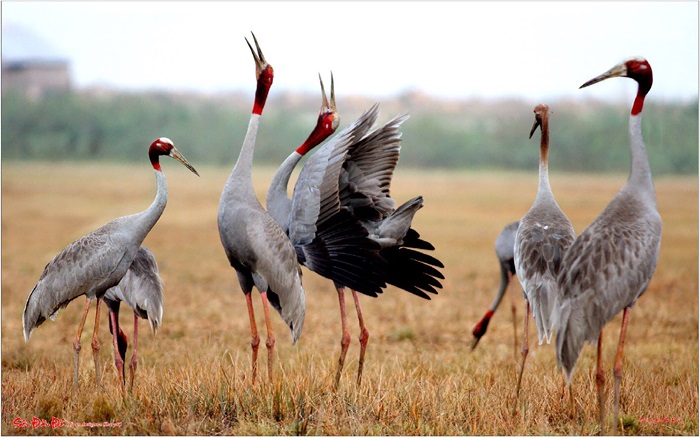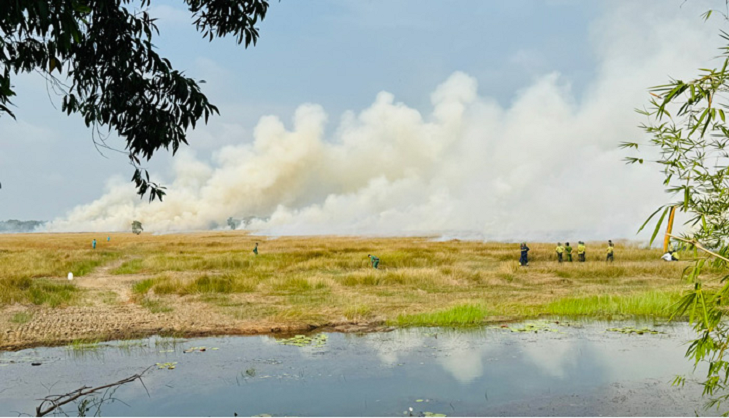Dong Thap Province Approves Plan for Sarus Crane Conservation and Development
On November 3rd, the People's Committee of Dong Thap province officially approved the "Plan for Sarus Crane Conservation and Development at Tram Chim National Park, phase 2022-2032".
On November 3rd, the People's Committee of Dong Thap province officially approved the "Plan for Sarus Crane Conservation and Development at Tram Chim National Park, phase 2022-2032".

Sarus Cranes at Tram Chim National Park. Photo: Nguyen Van Hung
The overall objective of the plan is to restore and develop the Sarus crane population at Tram Chim National Park through captive breeding and release into the wild. Within 10 years (2022-2032), the plan aims to raise and release 100 individuals, with a minimum survival rate of 50%. The released Sarus cranes are expected to reproduce naturally, establish a self-sustaining wild population, and potentially reside year-round in Tram Chim National Park.
The province sets a target for the period 2022-2028 to receive 30 six-month-old cranes from Thailand for breeding, care, and release into the natural environment. Infrastructure, including breeding facilities, will be completed to support the entire process. The Tram Chim National Park ecosystem will be restored through appropriate water regulation and research-based measures to create a suitable habitat for Sarus cranes.
The plan outlines a roadmap to convert approximately 200 hectares of rice fields to ecological production models by 2028, with a focus on organic agriculture in the neighboring areas of Tam Nong district. Within the first 5 years, the cranes are expected to reproduce and thrive both within and outside Tram Chim National Park.
In the period 2029-2032, the province will continue negotiations with Thailand to receive an additional 30 six-month-old cranes. It is estimated that around 40 cranes will be bred from the initial parent flock. Additionally, a distribution map of cranes living inside and outside Tram Chim National Park will be created. Technical staff at Tram Chim National Park will be trained to successfully care for, breed, and release cranes into the wild. The plan also aims to increase the number of households (10 households) participating in ecotourism activities, combining rice field tours with crane watching and other activities related to rice field ecology.
Sarus cranes were rediscovered in Tram Chim in 1985. The number of cranes recorded in Tram Chim once exceeded 1,000 individuals (1,058 individuals in 1988). From then until the late 1990s, Tram Chim was consistently the site with the largest number of Sarus cranes in the lower Mekong River region. The presence of Sarus cranes was one of the key reasons for the establishment of the Tram Chim wetland reserve, the precursor to today's Tram Chim National Park. However, due to various reasons, the number of Sarus cranes returning to Tram Chim has been steadily declining.
Source: 1127/QĐ-UBND-HC
Nguyet Anh
News

Tram Chim National Park Ready to Bring the Sarus Cranes Home
Tram Chim National Park is completing the final steps to prepare for bringing the sarus cranes home. This is an important part of the Conservation and Development Project for the Sarus Crane (2022 - 2032), aiming to restore the population of this rare bird species in the Dong Thap Muoi region."

Sarus Cranes relocated from Thailand recover well at Saigon Zoo
On the morning of April 13, at Saigon Zoo, where six cranes transferred to Vietnam from Nakhon Ratchasima Zoo (Thailand) are being quarantined, experts from Thailand, Vietnam, and the International Crane Foundation discussed and assessed the health status of the cranes after three days of isolated care.

Dong Thap Welcomes First 6 Sarus Cranes from Thailand
To restore and expand the population of sarus cranes in Tram Chim National Park through captive breeding and reintroduction efforts, Dong Thap Province received the first six cranes from Thailand on the evening of April 10, 2025.

Controlled burn on Zone A1, Tram Chim National Park
Fire has played a significant role in the creation and administration of Tram Chim National Park throughout the last four decades. Sometimes fire destroys, and in many cases fire helps regenerate.

Investing in Infrastructure to Serve the Sarus Crane Recovery Program
The Chairman of the Provincial People's Committee approved the infrastructure project for the second phase of the Sarus Crane development and restoration program at Tram Chim National Park. Tram Chim National Park serves as the project's investor.

Experts from the International Crane Foundation guide how to care for and raise sarus cranes
One of the primary tasks of the expert delegation from the International Crane Federation (ICF) during their week-long stay in Tram Chim National Park (Tam Nong area) was to assist Tram Chim National Park in completing the necessary stages for supplies and qualified workers to guarantee that the sarus crane captive breeding procedure is carried out.

Dong Thap province: Media training on the Sarus Crane Conservation Project
In the morning of November 20, Tam Nong District People's Committee arranged a training session on the topic of Sarus Cranes in Tram Chim National Park with the goal of educating, informing, and encouraging their development and restoration. This second course was offered both directly and online to leaders of several departments of Dong Thap province, and People's Committees at the district level.

Communication skills training for the Sarus Crane Development and Conservation Project
On November 14–15, Tam Nong District People's Committee held a training session to prepare knowledge and communication skills for the Project on the Sarus Crane Development and Conservation at Tram Chim National Park in 2024.

Conserving and Developing the Sarus Crane Population at Tram Chim National Park
The People's Committee of Dong Thap province has approved a project for the conservation and development of the sarus crane at Tram Chim National Park from 2022 to 2032, with a total estimated cost of over 184 billion VND.


